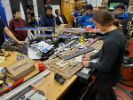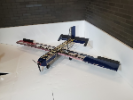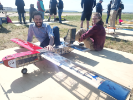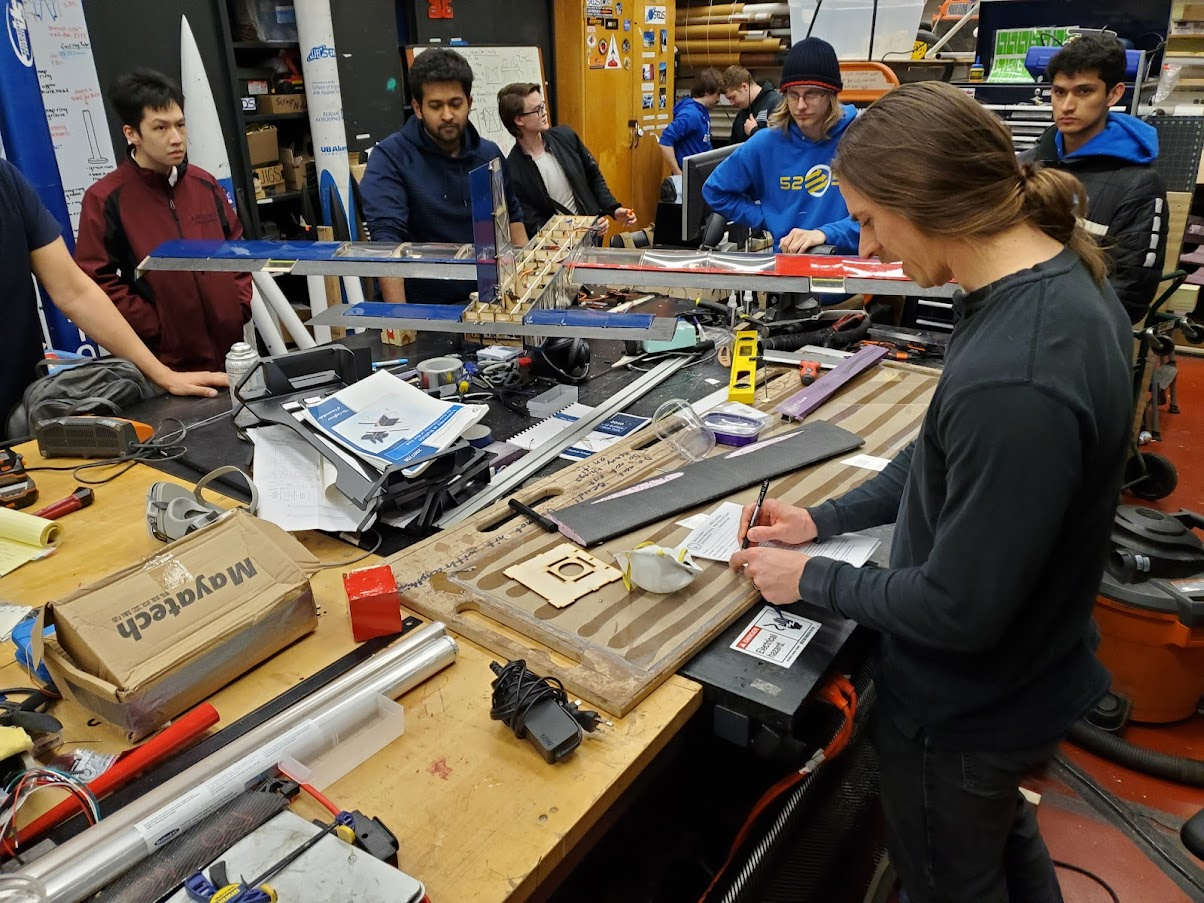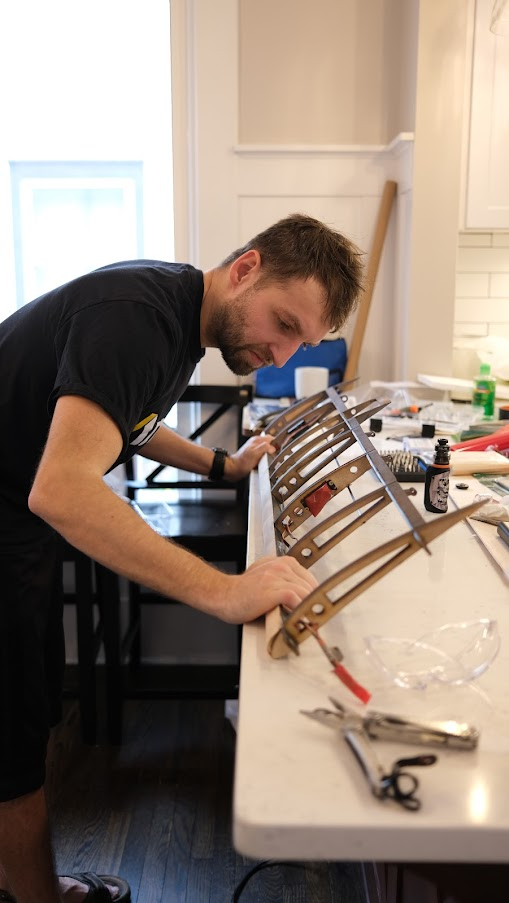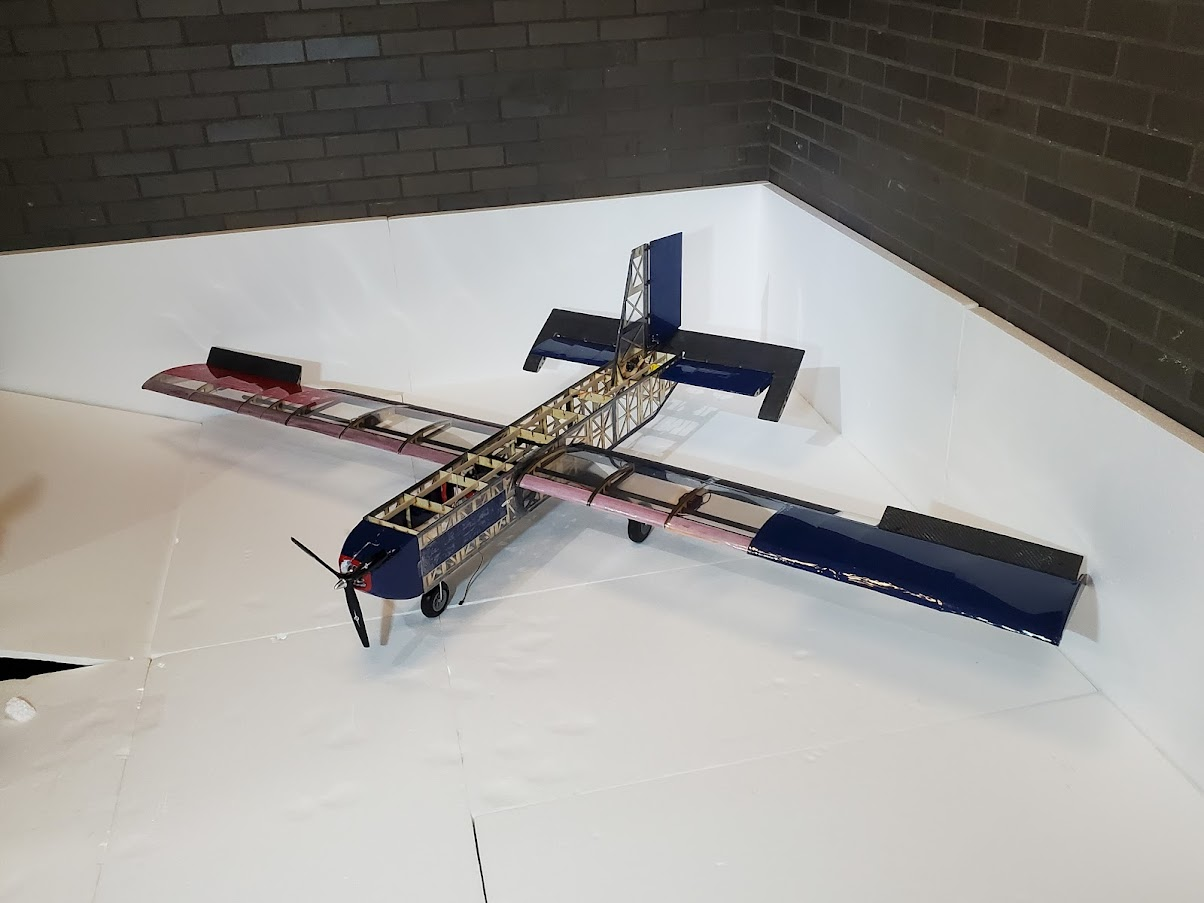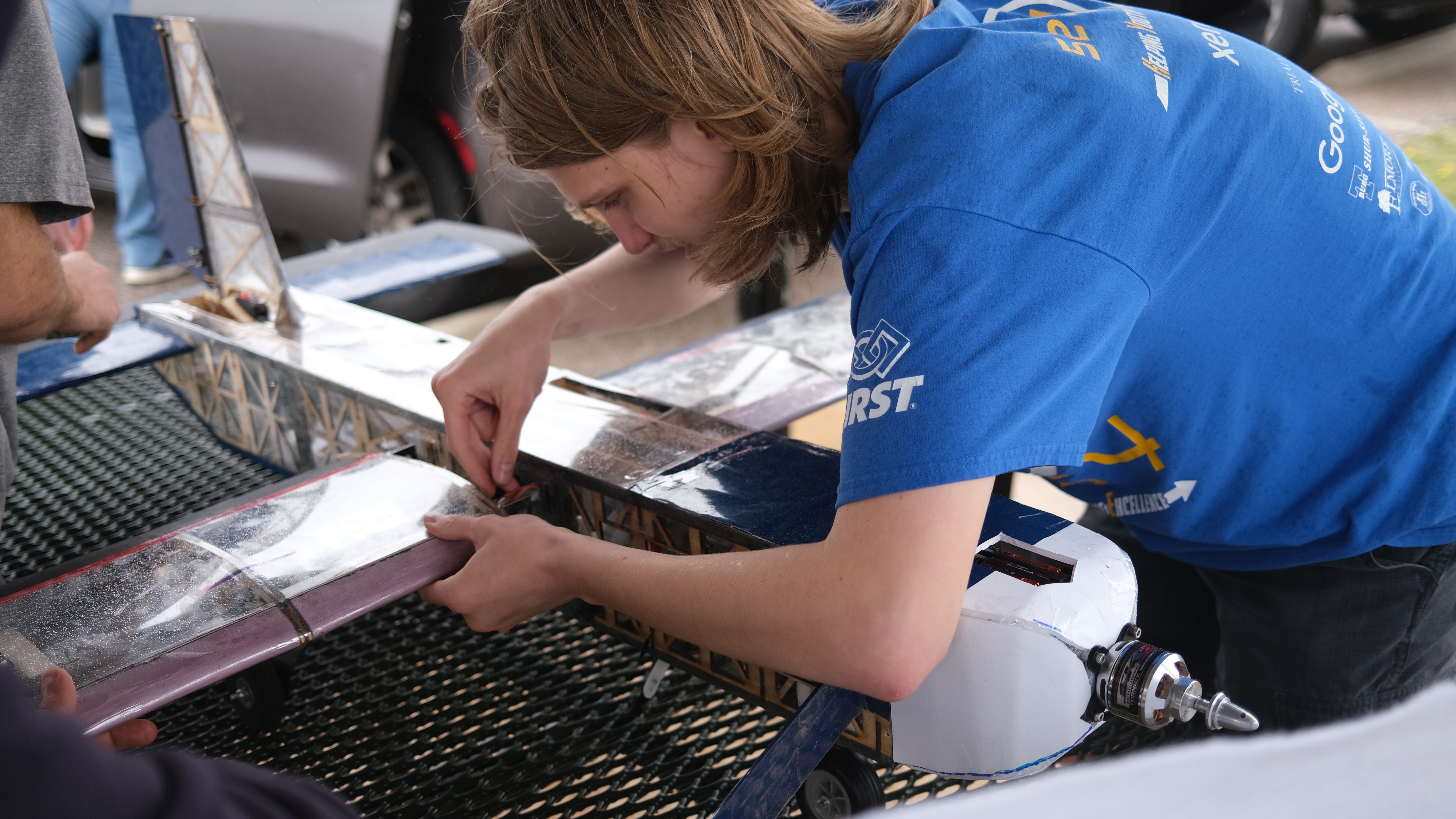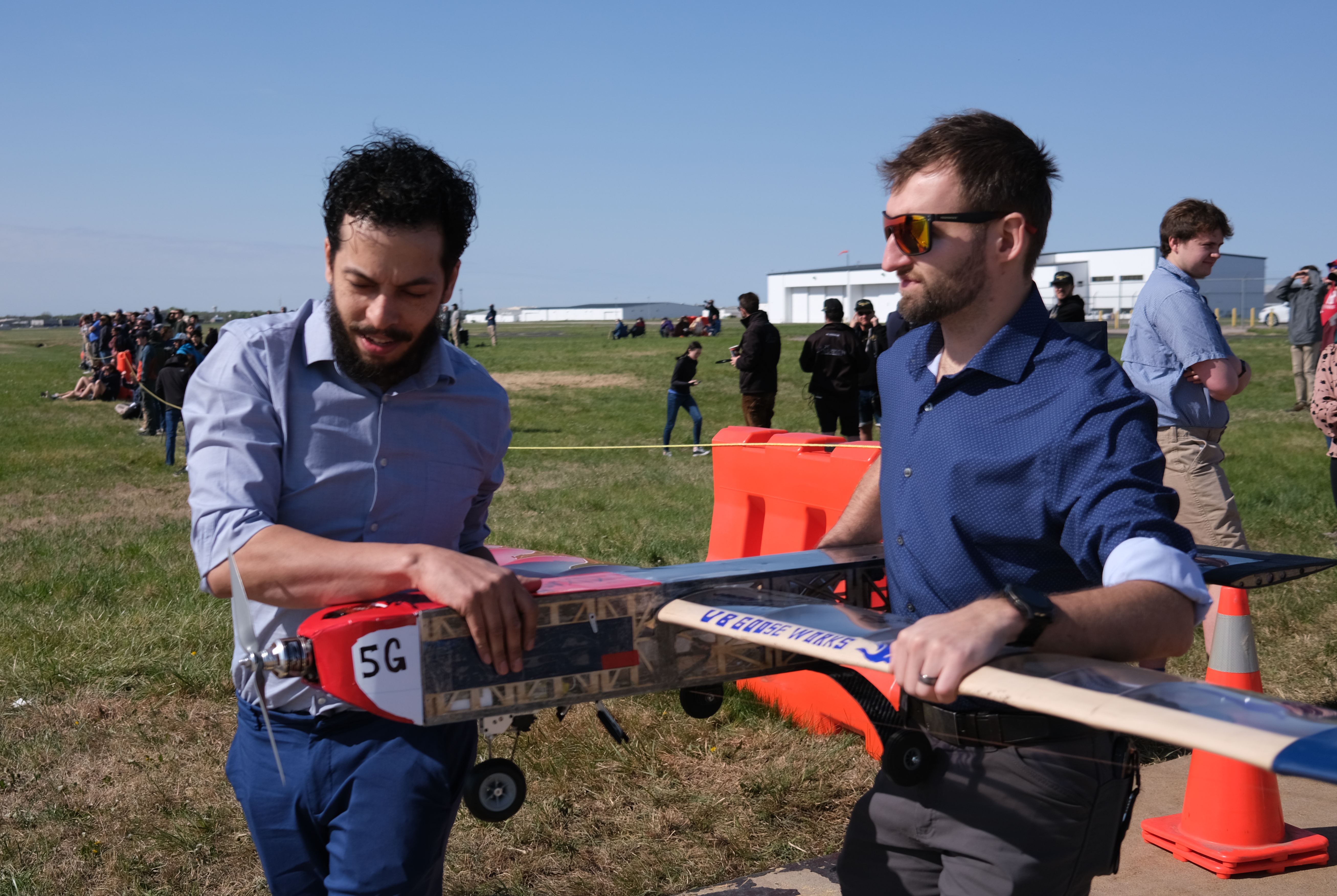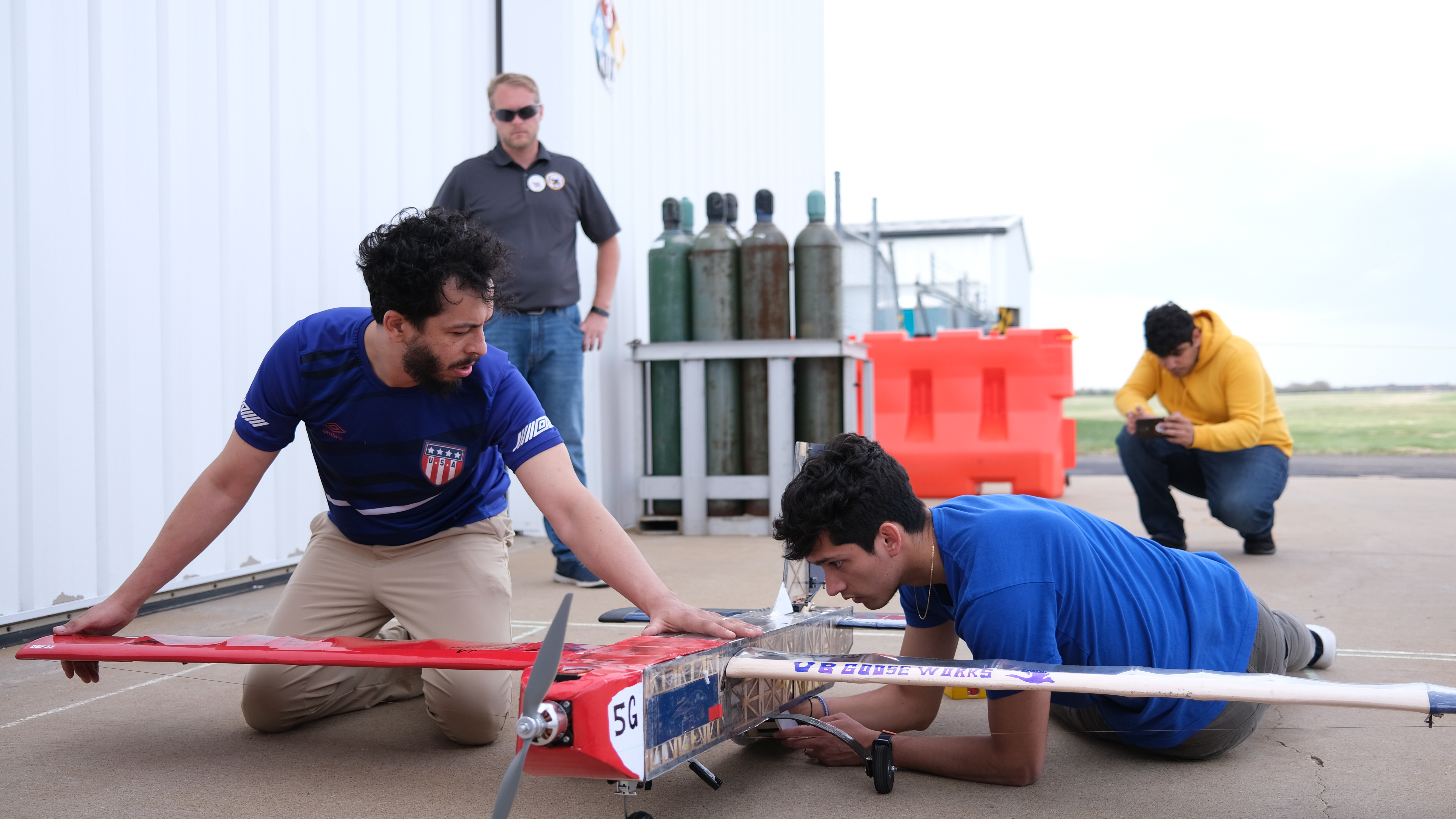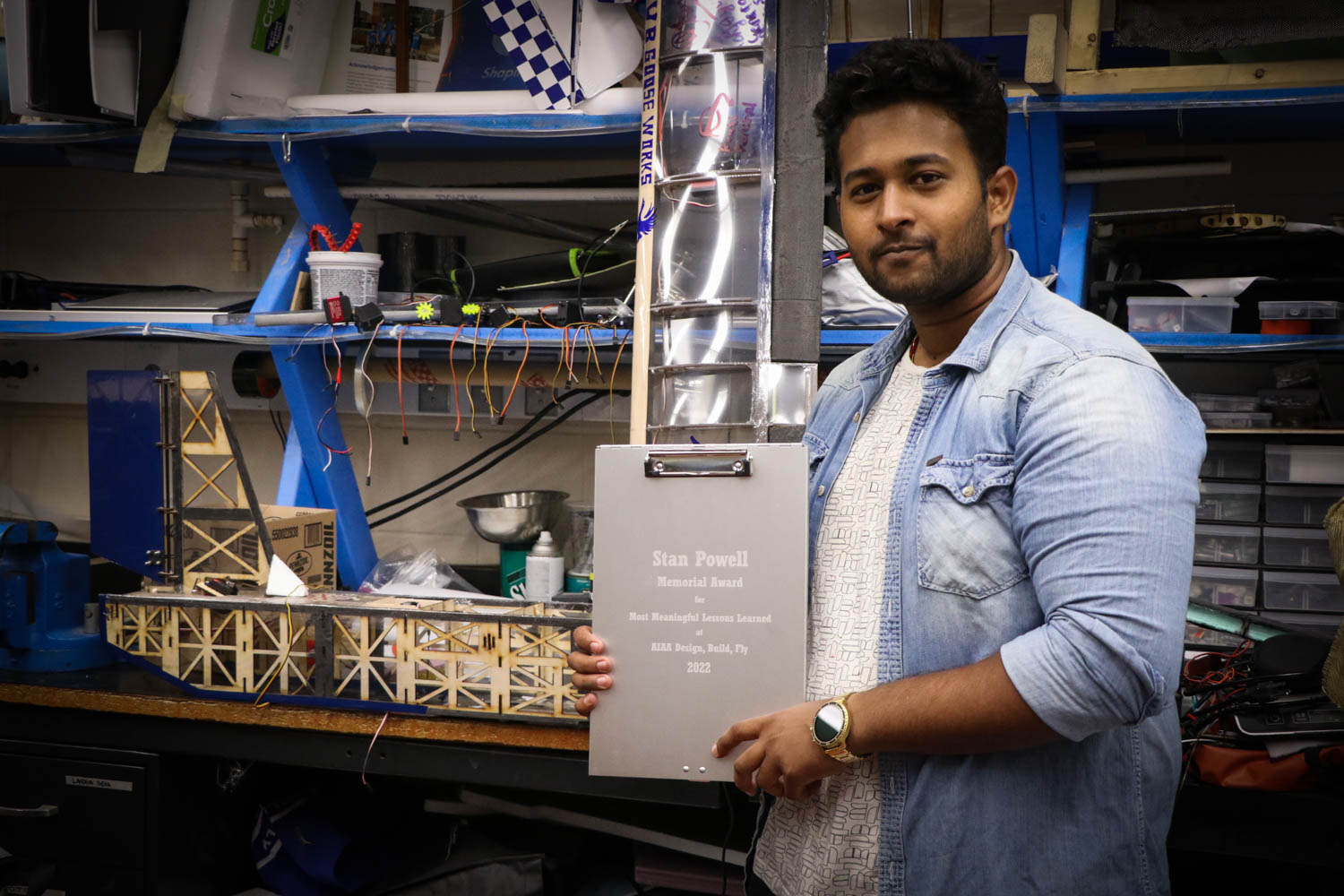Generosity and teamwork helps team fly high at competition

Incoming AIAA President and aerospace engineering student Aayush Kumar holds the Stan Powell Memorial Award in the team's Furnas Hall lab.
By Nicole Capozziello
Published July 15, 2022
It had been a long few days and sleepless nights for the University at Buffalo American Institute of Aeronautics and Astronautics (AIAA) team, which had been working around the clock to get their plane flight-ready for the 2022 AIAA Design/Build/Fly (DBF) Flyoff, an international competition held in Wichita, Kansas, on April 22-24, 2022.
After they had flown their plane but not placed in the competition, the exhausted team left before the event finale and awards ceremony. It was only later that they got the unexpected good news that they had been chosen as the recipients of an award: the Stan Powell Memorial Award for Most Meaningful Lessons Learned at AIAA Design/Build/Fly.
The team was selected for the award based on their personal determination and helping others. Despite challenges, they worked with competition tech inspectors to pass technical inspection and fly their plane. They not only showed resilience but exhibited generosity by helping one of their competitors, a small team from John Brown University, also get to the flight line.
“It was clear to us that you did not come to DBF with the intent of winning but for the learning experience,” Russ Althof, the director of the AIAA DBF Organizing Committee, told the team. “By embracing the experience, you have demonstrated what Stan would have expected to see.”
The award was created to honor Stan Powell, a long-time member of the DBF organizing committee who died last year. He emphasized that DBF is a learning experience and always took the time to assure students learned something, even a hard lesson, from their time. The award is given in the form of an engraved metal clipboard, just as Powell was known for having on the flight line to hold score sheets.
“I was proud to hear that our UB students weren't just concerned about their own test-flight, but were taking time to help others. I think that shows maturity and is great for UB’s reputation,” says Aaron Estes, the group’s faculty advisor and an assistant professor of teaching in the mechanical and aerospace engineering department. “I was consistently impressed over spring semester with the enthusiasm, work ethic and camaraderie among our UB AIAA club members. I was not surprised in the least bit that their character was recognized and awarded at this event!”
“There was more to the experience than actually winning,” says Aayush Kumar, incoming UB AIAA club president and a rising senior majoring in aerospace engineering. “Everyone on our team learned a lot, and everyone contributed, making this a successful year.”
Preparing for Wichita
Each year, the Design Build Fly competition challenges student teams from around the world to design, fabricate and demonstrate the flight capabilities of an unmanned, electric powered, radio-controlled aircraft in a particular mission. The 2022 mission was to design, build and test an aircraft to deliver vaccination components, which included deploying the aircraft, staging vaccination syringes and delivering environmentally sensitive vaccine vial packages.
The DBF team began working on their design proposal in November and submitted their written report in late January. Unfortunately, their written report was over length so the UB team went into the competition in last place.
However, the team was not deterred. They continued to build their prototype over the spring semester, working towards the goal of creating a balanced design that demonstrated good flight handling qualities and practical and affordable manufacturing while providing a high vehicle performance.
The team was proud to qualify for the DBF competition for the first time in three years. “We’ve been working to build a culture of growth and inclusion that reached a major point in its implementation this year,” says Alexander Podvezko, the 2021-2022 president of the UB AIAA club and a senior engineering science major. “Instead of only relying on upperclassmen and veteran members to call the shots, we got to see the proof that giving our newest members autonomy in design and access to the plane works, and it should be the norm.”
The UB AIAA club, which has over 250 members total and about 45 active members, also had a very successful fundraising year. Additionally, their efforts were supported by the UB Student Association and the School of Engineering and Applied Sciences Engineering Partnership fund. These funds allowed them to take more students than ever before to the competition and incorporate interesting new building materials into their design.
It enabled the team to integrate carbon fiber into their design for the first time and drew on a number of diverse skills for the plane’s dropping mechanism. Sam Nelson, the pilot for the 2022 competition and the new 2022-2023 team captain, utilized 3D printing to make the gears that actuated the conveyor belt that moved the packages out of the plane.
“By providing support for student clubs, the Engineering Partnership fund allows us to improve many students’ experiences in tangible ways. It’s wonderful to be able to provide students like those on the UB AIAA team with such a gratifying and potentially life-changing opportunity,” says Christine Human, associate dean for accreditation and student affairs for SEAS.
The Design/Build/Fly Competition
In April, 16 students set off for Wichita for the competition, which was hosted by Textron Aviation. The birthplace of companies such as Beechcraft and Cessna, Wichita is considered the Air Capital of the World, and has built around 300,000 aircraft. For DBF, more than 700 engineering students from universities in 13 countries gathered to test the radio-controlled aircraft they had designed and built.
The team was able to learn a lot from the event by actually testing their prototype and seeing and discussing other team’s building styles.
“During the trip, we encountered several issues that presented opportunities for on-the-fly problem solving. An issue of particular noteworthiness was when we purchased a toy RC car at the local Wal-Mart, which we took apart to trigger our mechanism's microcontroller. After disassembly, the wire leads were connected to our controller and through some troubleshooting by team member Fernando Ramos Siguenza, we were able to incorporate the hardware for complete functionality,” says Sean Hunt, the 2021-2022 team captain and a rising senior majoring in aerospace engineering. “I am very proud of our team's persistence and dedication at every turn, and especially the teamwork shown in the face of the many hurdles a project such as this is sure to endure.”
The team members also had the opportunity to connect with other students from around the world, watch Textron fly an experimental aircraft and network with representatives from top aerospace companies.
“When I was on the flight line in Kansas looking around at what other teams had built, and talking with some of our cohort from other schools, I realized that we had been given the unique opportunity to do bona fide real-deal aerospace engineering, from start to finish. Regardless of outcome, every team there designed a product to specification,” says Mark Sangregory, the group’s treasurer and a rising senior aerospace engineering major.
“As an underdog team, I’m proud that we ended up scoring at about the middle of the pack among close to 100 teams,” says Podvezko. “We proved that UB AIAA can compete at a national and international level. Engineering is always about pushing ahead to something better, and this award is proof that we can do great things together, and that the coming years will be even better.”
Planning for next year
The team’s Stan Powell Award – an engraved metal clipboard – now sits in the student aerospace lab on the 10th floor of Furnas Hall, along with their plane which is named 5G, standing for “Grand Gilded Gosling of Godly Glory.”
The team is already looking forward to and planning for next year. In 2023, they hope to stick more closely to their timeline for construction and testing at UB, as well as get more sponsors. The team also says a key take-away for future competitions is that a heavier plane performs better in the windy conditions common to Kansas.
“Overall, the greatest lesson is that by fostering an inclusive culture in our teams in UB AIAA, we bring that unity and joy of engineering with us everywhere we go. Our students have what it takes to make the world a better place,” says Podvezko.

